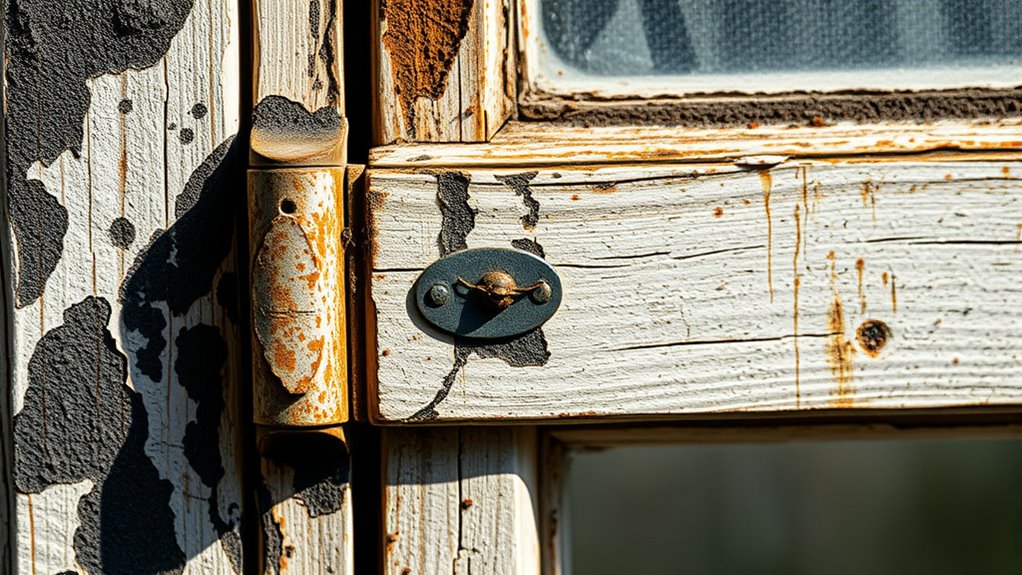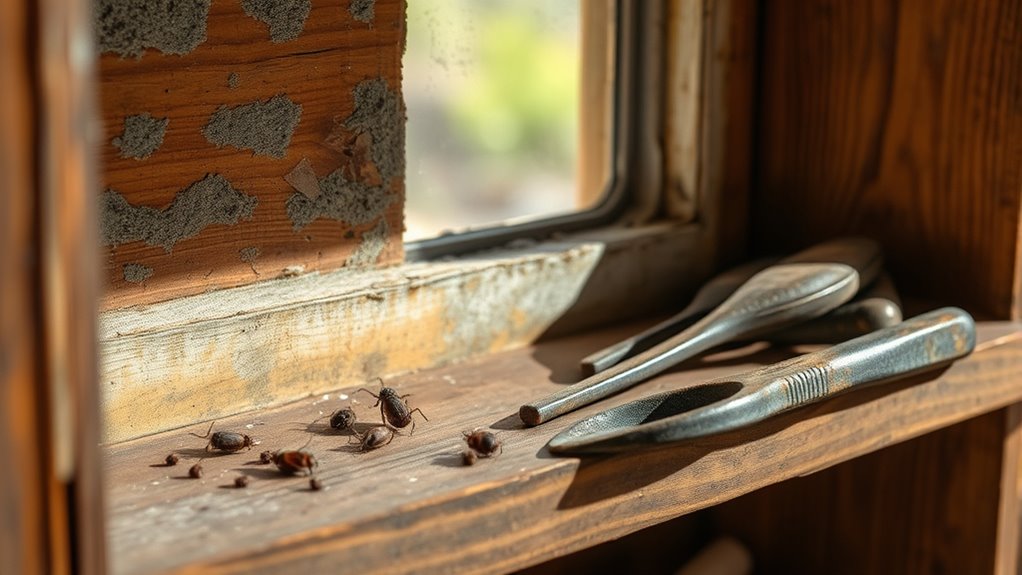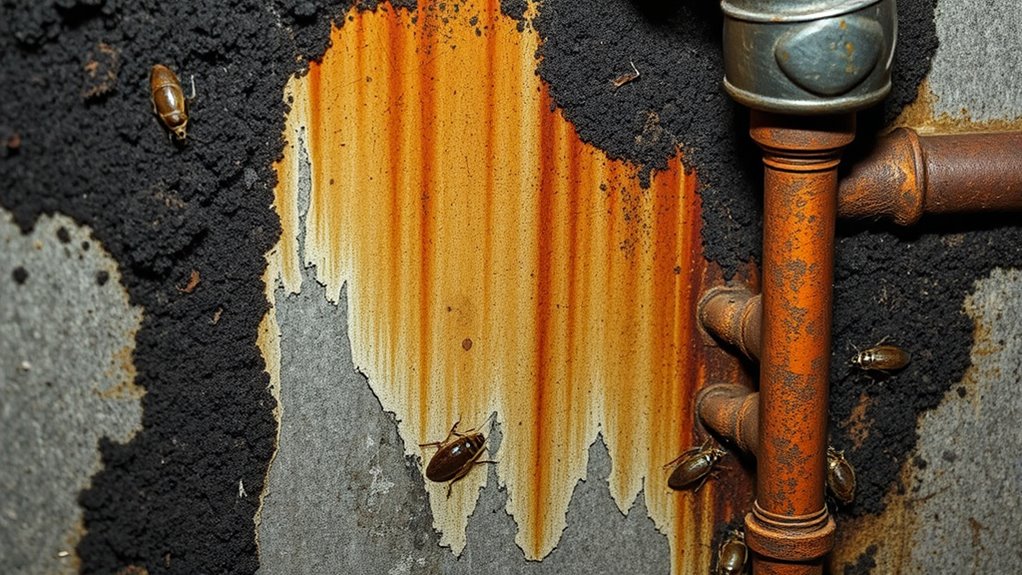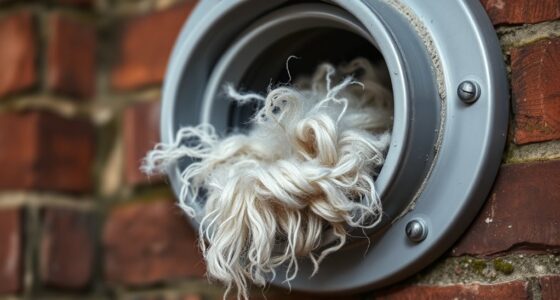To prevent mold, rust, and pests, keep your home dry and well-ventilated by opening windows, using exhaust fans, and maintaining humidity levels. Regularly inspect areas prone to moisture, like bathrooms and basements, and fix leaks early. Store items properly in sealed containers and seal gaps around doors, windows, and pipes. Good airflow, moisture control, and maintenance are key—continue exploring these tips to protect your home effectively.
Key Takeaways
- Maintain dry, well-ventilated spaces using exhaust fans and open windows to prevent mold and rust buildup.
- Regularly inspect and repair plumbing, seals, and insulation to reduce moisture entry points.
- Use airtight containers and sealed storage to protect items from pests and mold.
- Control indoor humidity with dehumidifiers and ensure proper airflow to inhibit mold and rust growth.
- Seal entry points and keep the home clean to prevent pests and reduce conditions conducive to mold and rust.
Keep Your Home Dry and Well-Ventilated

Keeping your home dry and well-ventilated is essential to prevent moisture buildup that can lead to mold and structural damage. Managing indoor humidity levels helps keep moisture control in check. Use exhaust fans in bathrooms and kitchens to reduce excess moisture from daily activities. Open windows regularly to promote air circulation and prevent stale, damp air from lingering. Installing vents and using dehumidifiers in humid seasons can further regulate indoor humidity. Keeping walls, ceilings, and floors dry prevents mold growth and deterioration. Make sure your home has proper insulation to avoid condensation. Regularly monitoring humidity levels can help you maintain optimal indoor conditions. By maintaining good airflow and controlling moisture, you create a less inviting environment for mold, pests, and rust, ensuring your home remains safe, healthy, and durable.
Regular Maintenance and Inspection Strategies

Regular maintenance and inspections are vital for catching potential issues early before they escalate into costly repairs or health hazards. Check your HVAC filters regularly, replacing them as needed to prevent mold growth and guarantee good air quality. Keep an eye out for signs of plumbing leaks, such as water stains, musty odors, or rising utility bills, and address them promptly. Inspect areas prone to moisture, like bathrooms and basements, for signs of mold or rust. Schedule routine professional inspections to identify hidden problems before they worsen. Consistent upkeep helps you catch small issues early, saving money and protecting your home’s integrity. Staying vigilant with these strategies minimizes the risk of pests, mold, and rust, keeping your home safe and comfortable. Additionally, understanding signs of spoilage in household items can help prevent health issues and waste.
Store Items Properly and Seal Entry Points

Properly storing your belongings and sealing potential entry points are essential steps in preventing home nightmares. Clutter organization makes it easier to identify what needs storage solutions and reduces hiding spots for pests or mold. Use airtight containers for food and moisture-prone items to prevent rust and mold growth. For clothes and linens, choose sealed plastic bins to keep pests out. Additionally, inspect your home for gaps around windows, doors, and pipes, then seal these entry points with weatherstripping or caulk. Doing so keeps pests and moisture where they belong—outside. Regularly checking and maintaining these seals ensures your home stays protected. Incorporating natural materials like wood and linen in your storage and sealing efforts can also enhance your home’s rustic charm while maintaining functionality. Proper storage and sealing are simple but effective ways to maintain a clean, pest-free, and mold-resistant environment.
Frequently Asked Questions
How Can I Identify Hidden Mold Behind Walls?
To identify hidden mold behind walls, look for signs like musty odors or unexplained stains. You can also check your wall insulation for dampness or discoloration. For a more accurate detection, consider mold testing, which can reveal hidden growth you can’t see. If you suspect mold, it’s best to consult professionals who can safely inspect and test your walls, ensuring your home stays healthy and mold-free.
What Are Natural Remedies to Prevent Rust?
Did you know that using natural remedies can reduce rust by up to 50%? To prevent rust naturally, you should regularly dry and clean metal surfaces. For DIY rust removal, try using lemon juice or vinegar—they break down rust effectively. Applying rust resistant coatings made from natural oils like coconut or linseed oil creates a protective barrier. These simple steps help keep your belongings rust-free without harsh chemicals.
Which Pests Are Most Common in Damp Homes?
In damp homes, you’ll most likely encounter basement pests like silverfish and centipedes, which thrive in moisture. Attic invaders such as mice and roof rats often seek out warm, humid spaces. To keep them out, guarantee proper ventilation, seal cracks, and reduce humidity. Regularly inspect these areas, clean clutter, and store food securely. Taking these steps helps prevent pests from nesting and creating further issues inside your home.
How Often Should I Inspect My Home for Pests?
Have you considered how often you should check your home for pests? Regular home maintenance is key to pest prevention. You should inspect your property at least once a month for signs of pests, especially in damp or hidden areas. Look for droppings, damage, or nests. Staying vigilant helps catch issues early and keeps your home pest-free, preventing larger problems down the line. Consistent inspections are your best defense.
Are There Eco-Friendly Sealing Options for Entry Points?
You want to know about eco-friendly sealing options for entry points. Look for eco-friendly sealants and sustainable caulking products made from natural or non-toxic materials. These options are effective at sealing gaps while minimizing environmental impact. You can find them at most hardware stores or online. Using sustainable caulking helps reduce your home’s chemical footprint and keeps pests out, making your home healthier and more eco-conscious.
Conclusion
So, you’ve got the tips to keep mold, rust, and pests at bay—yet, somehow, the real nightmare is neglecting them until it’s too late. Ironically, a little effort now can save you a mountain of trouble later. Don’t wait for those pesky invaders to move in before you take action. Stay vigilant, stay dry, and keep pests out—because in the end, your home’s peace of mind depends on the habits you build today.









